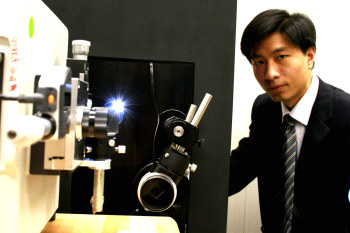
Hongbo Zeng uses a surface forces apparatus (SFA) to measure the friction, adhesion and lubrication at the molecular and nano scales. The device is sensitive enough to detect the slightest amount of force-measuring it in nano-Newtons, and has a distance resolution of 0.1 nanometre.
Edmonton-Mussels, those ancient little bivalves, may be turning their bothersome behaviour of clinging in huge numbers to just about any surface into a positive use for human health care.
Hongbo Zeng, a professor in the Department of Chemical and Materials Engineering, is taking a close look at the adhesion process of the mussel's foot, the body part it uses to attach itself to an underwater surface. Mussels latch onto natural surfaces like rocks and wooden piers and even slick, man-made surfaces like the hulls of ships, in such great numbers that they slow the speed of the vessel. In fact, some Canadian municipalities have declared war on mussels because they establish colonies that clog water intake pipes.
"It's their ability to attach to surfaces underwater that makes the chemistry of mussels a possible breakthrough for use for bio-medical applications," says Zeng. He explains that an adhesive that mimics the protein action on the surface of the mussel's foot could produce a naturally biodegradable glue to replace stitches for minor cuts and could be used by surgeons on internal organs.
Zeng's mussel research could also lead to super-glue for industrial use in a saltwater environment. "The cuticle of the mussel's foot has a self-healing chemical process through the interactions between metal ions and proteins," says Zeng, who envisions a day when a mussel inspired bio-material, integrated into a common product like a rubber hose, will give it the feature of self repairing cracks caused by aging in a saltwater environment.
Zeng has recently written and co-written three papers on mussels. The papers appear in the Proceedings of the National Academy of Science, the Journal of Biological Chemistry and Soft Matter.